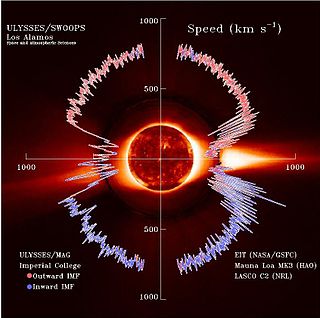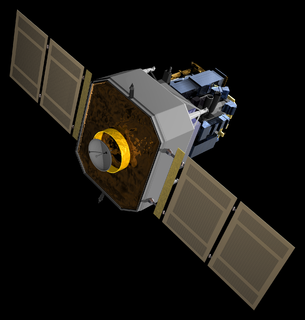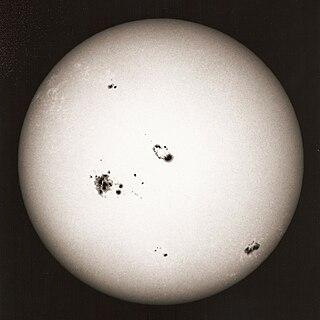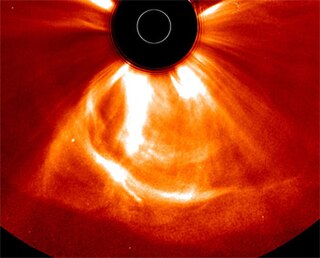
The solar wind is a stream of charged particles released from the upper atmosphere of the Sun, called the corona. This plasma mostly consists of electrons, protons and alpha particles with kinetic energy between 0.5 and 10 keV. The composition of the solar wind plasma also includes a mixture of materials found in the solar plasma: trace amounts of heavy ions and atomic nuclei such as C, N, O, Ne, Mg, Si, S, and Fe. There are also rarer traces of some other nuclei and isotopes such as P, Ti, Cr, 54Fe and 56Fe, and 58Ni, 60Ni, and 62Ni. Superposed with the solar-wind plasma is the interplanetary magnetic field. The solar wind varies in density, temperature and speed over time and over solar latitude and longitude. Its particles can escape the Sun's gravity because of their high energy resulting from the high temperature of the corona, which in turn is a result of the coronal magnetic field.

A solar flare is an intense eruption of electromagnetic radiation in the Sun's atmosphere. Flares occur in active regions and are often, but not always, accompanied by coronal mass ejections and solar particle events.

Space weather is a branch of space physics and aeronomy, or heliophysics, concerned with the time varying conditions within the Solar System, including the solar wind, emphasizing the space surrounding the Earth, including conditions in the magnetosphere, ionosphere, thermosphere, and exosphere. Space weather is distinct from but conceptually related to the terrestrial weather of the atmosphere of Earth. The term space weather was first used in the 1950s and came into common usage in the 1990s.

A geomagnetic storm, also known as a magnetic storm, is a temporary disturbance of the Earth's magnetosphere caused by a solar wind shock wave and/or cloud of magnetic field that interacts with the Earth's magnetic field.

A coronal mass ejection (CME) is a significant release of plasma and accompanying magnetic field from the solar corona. They often follow solar flares and are normally present during a solar prominence eruption. The plasma is released into the solar wind, and can be observed in coronagraph imagery. The term "mass" in the name doesn't refer to the size but instead that mass is being ejected rather than just photons, as smaller solar flares often only release.

The Solar and Heliospheric Observatory (SOHO) is a spacecraft built by a European industrial consortium led by Matra Marconi Space that was launched on a Lockheed Martin Atlas II AS launch vehicle on December 2, 1995, to study the Sun. It has also discovered over 4,000 comets. It began normal operations in May 1996. It is a joint project between the European Space Agency (ESA) and NASA. Originally planned as a two-year mission, SOHO continues to operate after over 25 years in space; the mission has been extended until the end of 2020 with a likely extension until 2022.
A solar storm is a disturbance on the Sun, which can emanate outward across the heliosphere, affecting the entire Solar System, including Earth and its magnetosphere, and is the cause of space weather in the short-term with long-term patterns comprising space climate.

Solar energetic particles (SEP) are high-energy particles coming from the Sun. They were first observed in the early 1940s. They consist of protons, electrons and HZE ions with energy ranging from a few tens of keV to many GeV. They are of particular interest and importance because they can endanger life in outer space.

Solar Cycle 24 is the most recently completed solar cycle, the 24th since 1755, when extensive recording of solar sunspot activity began. It began in December 2008 with a smoothed minimum sunspot number of 2.2, and ended in December 2019. Activity was minimal until early 2010. It reached its maximum in April 2014 with a 23 months smoothed sunspot number of 81.8. This maximum value was substantially lower than other recent solar cycles, down to a level which had not been seen since cycles 12 to 15 (1878-1923).

The Carrington Event was a powerful geomagnetic storm on 1–2 September 1859, during solar cycle 10 (1855–1867). A solar coronal mass ejection (CME) hit Earth's magnetosphere and induced the largest geomagnetic storm on record. The associated "white light flare" in the solar photosphere was observed and recorded by British astronomers Richard Carrington and Richard Hodgson. The storm created strong auroral displays and caused serious damage to telegraph systems. The now-standard unique IAU identifier for this flare is SOL1859-09-01.

The March 1989 geomagnetic storm occurred as part of severe to extreme solar storms during early to mid March 1989, the most notable being a geomagnetic storm that struck Earth on March 13. This geomagnetic storm caused a nine-hour outage of Hydro-Québec's electricity transmission system. The onset time was exceptionally rapid. Other historically significant solar storms occurred later in 1989, during a very active period of solar cycle 22.

Energetic neutral atom (ENA) imaging, often described as "seeing with atoms", is a technology used to create global images of otherwise invisible phenomena in the magnetospheres of planets and throughout the heliosphere.

Solar cycle 23 was the 23rd solar cycle since 1755, when extensive recording of solar sunspot activity began. The solar cycle lasted 12.3 years, beginning in August 1996 and ending in December 2008. The maximum smoothed sunspot number observed during the solar cycle was 180.3, and the starting minimum was 11.2. During the minimum transit from solar cycle 23 to 24, there were a total of 817 days with no sunspots. Compared to the last several solar cycles, it was fairly average in terms of activity.

A solar particle event or solar proton event (SPE), or prompt proton event, occurs when particles emitted by the Sun, mostly protons, become accelerated either in the solar atmosphere during a solar flare or in interplanetary space by a coronal mass ejection shock. Other nuclei such as helium and HZE ions may also be accelerated during the event. These particles can penetrate the Earth's magnetic field and cause partial ionization of the ionosphere. Energetic protons are a significant radiation hazard to spacecraft and astronauts.

The Halloween solar storms were a series of solar flares and coronal mass ejections that occurred from mid-October to early November 2003, peaking around October 28–29. This series of storms generated the largest solar flare ever recorded by the GOES system, modeled as strong as X45.

The solar storm of 2012 was an unusually large and strong coronal mass ejection (CME) event that occurred on July 23 that year. It missed Earth with a margin of approximately nine days, as the equator of the Sun rotates around its own axis with a period of about 25 days.

Solar phenomena are the natural phenomena occurring within the magnetically heated outer atmospheres in the Sun. These phenomena take many forms, including solar wind, radio wave flux, energy bursts such as solar flares, coronal mass ejection or solar eruptions, coronal heating and sunspots.
Lagrange is a 2018 concept study for a solar weather mission by the European Space Agency (ESA). This is a British-led concept that envisions two spacecraft to be positioned at Lagrangian points L1 and L5.

The solar storms of August 1972 were a historically powerful series of solar storms with intense to extreme solar flare, solar particle event, and geomagnetic storm components in early August 1972, during solar cycle 20. The storm caused widespread electric‐ and communication‐grid disturbances through large portions of North America as well as satellite disruptions. On August 4, 1972, the storm caused the accidental detonation of numerous U.S. naval mines near Haiphong, North Vietnam. The coronal cloud's transit time from the Sun to the Earth is the fastest ever recorded.
Tamitha Skov is a space weather physicist, researcher and public speaker based in Los Angeles. She is also referred to as "Space Weather Woman" in social media, where she forecasts and analyzes space weather processes - in the heliosphere and exosphere, in addition to her conducting the same in traditional media. Skov is presently serving as a research scientist at The Aerospace Corporation and as an adjunct professor of heliophysics and space weather at Millerville University.

















